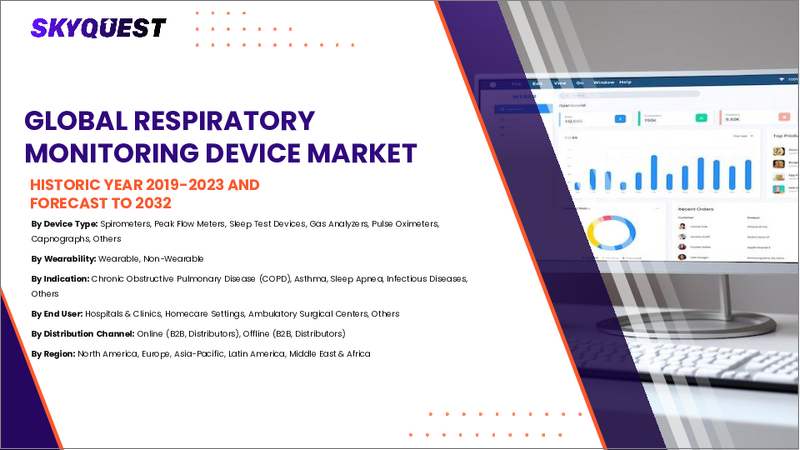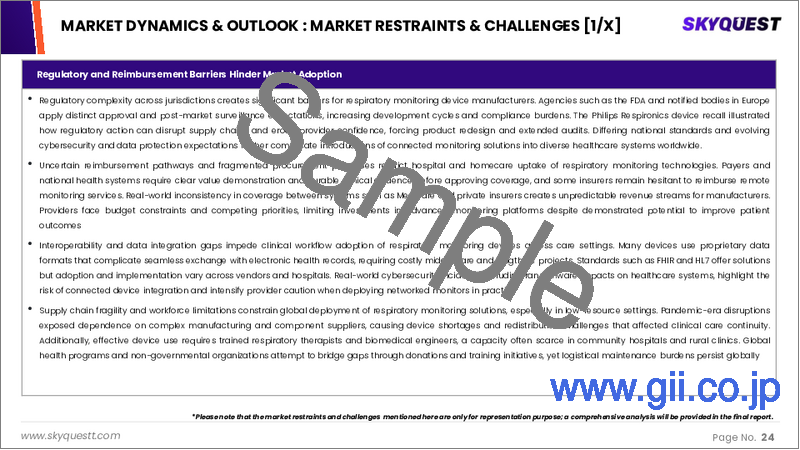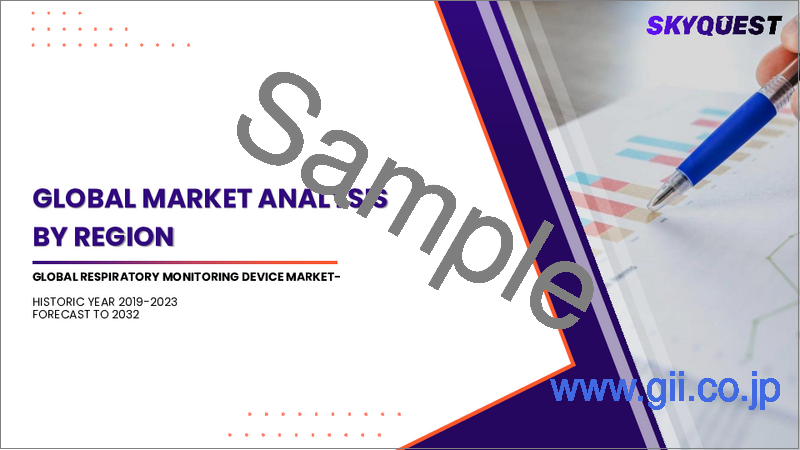|
|
市場調査レポート
商品コード
1633555
呼吸モニタリングデバイスの市場規模、シェア、成長分析:デバイスタイプ別、適応症別、エンドユーザー別、流通チャネル別、地域別 - 産業予測、2025年~2032年Respiratory Monitoring Device Market Size, Share, Growth Analysis, By Type of Device, By Indication (Chronic Obstructive Pulmonary Disease, Asthma), By End User, By Distribution Channel, By Region - Industry Forecast 2025-2032 |
||||||
|
|||||||
| 呼吸モニタリングデバイスの市場規模、シェア、成長分析:デバイスタイプ別、適応症別、エンドユーザー別、流通チャネル別、地域別 - 産業予測、2025年~2032年 |
|
出版日: 2025年01月14日
発行: SkyQuest
ページ情報: 英文 193 Pages
納期: 3~5営業日
|
全表示
- 概要
- 目次
呼吸モニタリングデバイスの世界市場規模は2023年に46億米ドルと評価され、2024年の49億2,000万米ドルから2032年には83億9,000万米ドルに成長し、予測期間(2025-2032年)のCAGRは6.9%で成長する見通しです。
呼吸モニタリングデバイスの世界市場は、COVID-19の大流行時に急増したが、これは感染患者が直面する呼吸器系の問題の高まりと、在宅医療や医療環境全体におけるこうした機器の使用増加によるものです。この成長動向は、インドなどの新興諸国における医療費の増加と呼吸器疾患の有病率の上昇に後押しされ、今後も続くと予想されます。製品技術の革新は、市場力学をさらに強化すると思われます。さらに、2010年から2050年までに発展途上国で250%以上増加すると予測される高齢者人口の増加は、高齢化がより高い呼吸器リスクと相関することから、呼吸モニタリングデバイスの需要の増加傾向を示唆しています。糖尿病や喘息に匹敵する有病率である睡眠時無呼吸症候群のような疾患は、米国のような市場での需要をさらに刺激します。
目次
イントロダクション
- 調査の目的
- 調査範囲
- 定義
調査手法
- 情報調達
- 二次データと一次データの方法
- 市場規模予測
- 市場の前提条件と制限
エグゼクティブサマリー
- 世界市場の見通し
- 供給と需要の動向分析
- セグメント別機会分析
市場力学と見通し
- 市場概要
- 市場規模
- 市場力学
- 促進要因と機会
- 抑制要因と課題
- ポーターの分析
主な市場の考察
- 重要成功要因
- 競合の程度
- 主な投資機会
- 市場エコシステム
- 市場の魅力指数(2024年)
- PESTEL分析
- マクロ経済指標
- バリューチェーン分析
- 価格分析
- ケーススタディ
- 技術の進歩
- 規制情勢
- スタートアップ分析
- 特許分析
呼吸モニタリングデバイス市場規模:デバイスタイプ別& CAGR(2025-2032)
- 市場概要
- スパイロメーター
- ピークフローメーター
- 睡眠検査装置
- 呼吸ガス分析装置
- パルスオキシメーター
- カプノグラフ
- その他
呼吸モニタリングデバイス市場規模:適応症別& CAGR(2025-2032)
- 市場概要
- 慢性閉塞性肺疾患(COPD)
- 喘息
- 睡眠時無呼吸症候群
- 感染症
- その他
呼吸モニタリングデバイス市場規模:エンドユーザー別& CAGR(2025-2032)
- 市場概要
- 病院
- クリニック
- ホームケア設定
- 外来手術センター
呼吸モニタリングデバイス市場規模:流通チャネル別& CAGR(2025-2032)
- 市場概要
- オンラインストア
- 薬局
- その他
呼吸モニタリングデバイス市場規模:地域別& CAGR(2025-2032)
- 北米
- 米国
- カナダ
- 欧州
- ドイツ
- スペイン
- フランス
- 英国
- イタリア
- その他欧州地域
- アジア太平洋地域
- 中国
- インド
- 日本
- 韓国
- その他アジア太平洋地域
- ラテンアメリカ
- ブラジル
- その他ラテンアメリカ地域
- 中東・アフリカ
- GCC諸国
- 南アフリカ
- その他中東・アフリカ
競合情報
- 上位5社の比較
- 主要企業の市場ポジショニング(2024年)
- 主な市場企業が採用した戦略
- 市場の最近の動向
- 企業の市場シェア分析(2024年)
- 主要企業の企業プロファイル
- 会社概要
- 製品ポートフォリオ分析
- セグメント別シェア分析
- 収益の前年比比較(2022-2024)
主要企業プロファイル
- Medtronic plc(Ireland)
- GE Healthcare(United States)
- Philips Healthcare(Netherlands)
- ResMed Inc.(United States)
- Masimo Corporation(United States)
- Nihon Kohden Corporation(Japan)
- Siemens Healthineers(Germany)
- MGC Diagnostics Corporation(United States)
- Hamilton Medical AG(Switzerland)
- Getinge AB(Sweden)
- Baxter International Inc.(United States)
- Teleflex Incorporated(United States)
- Invacare Corporation(United States)
- Fisher & Paykel Healthcare Corporation Limited(New Zealand)
- 3M Company(United States)
結論と推奨事項
Global Respiratory Monitoring Device Market size was valued at USD 4.6 billion in 2023 and is poised to grow from USD 4.92 billion in 2024 to USD 8.39 billion by 2032, growing at a CAGR of 6.9% during the forecast period (2025-2032).
The global market for respiratory monitoring devices has surged during the COVID-19 pandemic, driven by the heightened respiratory issues faced by infected patients and the increased usage of such equipment across home care and medical environments. This growth trend is expected to continue, fueled by rising healthcare expenditures in developing countries such as India, coupled with a rising prevalence of respiratory conditions. Innovations in product technology are likely to further enhance market dynamics. Additionally, the growing elderly population-projected to increase over 250% in developing nations from 2010 to 2050-suggests an uptrend in demand for respiratory monitoring devices as aging correlates with higher respiratory risk. Conditions like sleep apnea, which rival diabetes and asthma in prevalence, further catalyze demand in markets like the U.S.
Top-down and bottom-up approaches were used to estimate and validate the size of the Global Respiratory Monitoring Device market and to estimate the size of various other dependent submarkets. The research methodology used to estimate the market size includes the following details: The key players in the market were identified through secondary research, and their market shares in the respective regions were determined through primary and secondary research. This entire procedure includes the study of the annual and financial reports of the top market players and extensive interviews for key insights from industry leaders such as CEOs, VPs, directors, and marketing executives. All percentage shares split, and breakdowns were determined using secondary sources and verified through Primary sources. All possible parameters that affect the markets covered in this research study have been accounted for, viewed in extensive detail, verified through primary research, and analyzed to get the final quantitative and qualitative data.
Global Respiratory Monitoring Device Market Segmental Analysis
Global Respiratory Monitoring Device Market is segmented by Type of Device, Indication, End User, Distribution Channel and region. Based on Type of Device, the market is segmented into Spirometers, Peak Flow Meters, Sleep Test Devices, Gas Analyzers, Pulse Oximeters, Capnographs and Other. Based on Indication, the market is segmented into Chronic Obstructive Pulmonary Disease (COPD), Asthma, Sleep Apnea, Infectious Diseases and Other. Based on End User, the market is segmented into Hospitals, Clinics, Homecare Settings and Ambulatory Surgical Centers. Based on Distribution Channel, the market is segmented into Online Stores, Pharmacies and Others. Based on region, the market is segmented into North America, Europe, Asia Pacific, Latin America and Middle East & Africa.
Driver of the Global Respiratory Monitoring Device Market
The Global Respiratory Monitoring Device market is experiencing significant growth driven by heightened awareness regarding respiratory health among both the public and healthcare professionals. This increasing awareness emphasizes the importance of monitoring respiratory conditions, leading to early detection and improved quality of life for patients. Additionally, the shift towards remote patient monitoring and the surge in demand for essential devices such as pulse oximeters, particularly during the pandemic, further fuels this market. Overall, the combination of these factors is creating a robust environment for the adoption of respiratory monitoring technologies, driving the market forward significantly.
Restraints in the Global Respiratory Monitoring Device Market
The Global Respiratory Monitoring Device market faces several constraints that may hinder its growth and adoption. Technical challenges associated with certain devices can lead to concerns regarding precision and reliability, which in turn may make healthcare professionals hesitant to fully embrace these advancements. Additionally, practitioners who are accustomed to conventional methods may demonstrate reluctance towards integrating new technologies into their practices. Furthermore, healthcare systems often exhibit resistance to change, complicating the process of transitioning to innovative monitoring solutions. These factors collectively contribute to a stifled growth environment for respiratory monitoring devices despite their potential benefits in patient care.
Market Trends of the Global Respiratory Monitoring Device Market
The Global Respiratory Monitoring Device market is experiencing a significant shift towards the adoption of portable and home-based technologies, driven by the increasing prevalence of chronic respiratory conditions like asthma and COPD. This trend reflects a growing consumer preference for convenient, accessible healthcare solutions that facilitate remote monitoring and management of respiratory health. As patients seek to minimize hospital visits and enhance their quality of life, innovative devices such as home ventilators and portable oxygen concentrators are becoming more prevalent. This movement aligns with the broader industry emphasis on patient-centric care, paving the way for advancements in respiratory monitoring technologies and expanding market opportunities.
Table of Contents
Introduction
- Objectives of the Study
- Scope of the Report
- Definitions
Research Methodology
- Information Procurement
- Secondary & Primary Data Methods
- Market Size Estimation
- Market Assumptions & Limitations
Executive Summary
- Global Market Outlook
- Supply & Demand Trend Analysis
- Segmental Opportunity Analysis
Market Dynamics & Outlook
- Market Overview
- Market Size
- Market Dynamics
- Drivers & Opportunities
- Restraints & Challenges
- Porters Analysis
- Competitive rivalry
- Threat of substitute
- Bargaining power of buyers
- Threat of new entrants
- Bargaining power of suppliers
Key Market Insights
- Key Success Factors
- Degree of Competition
- Top Investment Pockets
- Market Ecosystem
- Market Attractiveness Index, 2024
- PESTEL Analysis
- Macro-Economic Indicators
- Value Chain Analysis
- Pricing Analysis
- Case Studies
- Technology Advancement
- Regulatory Landscape
- Startup Analysis
- Patent Analysis
Global Respiratory Monitoring Device Market Size by Type of Device & CAGR (2025-2032)
- Market Overview
- Spirometers
- Peak Flow Meters
- Sleep Test Devices
- Gas Analyzers
- Pulse Oximeters
- Capnographs
- Other
Global Respiratory Monitoring Device Market Size by Indication & CAGR (2025-2032)
- Market Overview
- Chronic Obstructive Pulmonary Disease (COPD)
- Asthma
- Sleep Apnea
- Infectious Diseases
- Other
Global Respiratory Monitoring Device Market Size by End User & CAGR (2025-2032)
- Market Overview
- Hospitals
- Clinics
- Homecare Settings
- Ambulatory Surgical Centers
Global Respiratory Monitoring Device Market Size by Distribution Channel & CAGR (2025-2032)
- Market Overview
- Online Stores
- Pharmacies
- Others
Global Respiratory Monitoring Device Market Size & CAGR (2025-2032)
- North America (Type of Device, Indication, End User, Distribution Channel)
- US
- Canada
- Europe (Type of Device, Indication, End User, Distribution Channel)
- Germany
- Spain
- France
- UK
- Italy
- Rest of Europe
- Asia Pacific (Type of Device, Indication, End User, Distribution Channel)
- China
- India
- Japan
- South Korea
- Rest of Asia-Pacific
- Latin America (Type of Device, Indication, End User, Distribution Channel)
- Brazil
- Rest of Latin America
- Middle East & Africa (Type of Device, Indication, End User, Distribution Channel)
- GCC Countries
- South Africa
- Rest of Middle East & Africa
Competitive Intelligence
- Top 5 Player Comparison
- Market Positioning of Key Players, 2024
- Strategies Adopted by Key Market Players
- Recent Developments in the Market
- Company Market Share Analysis, 2024
- Company Profiles of All Key Players
- Company Details
- Product Portfolio Analysis
- Company's Segmental Share Analysis
- Revenue Y-O-Y Comparison (2022-2024)
Key Company Profiles
- Medtronic plc (Ireland)
- Company Overview
- Business Segment Overview
- Financial Updates
- Key Developments
- GE Healthcare (United States)
- Company Overview
- Business Segment Overview
- Financial Updates
- Key Developments
- Philips Healthcare (Netherlands)
- Company Overview
- Business Segment Overview
- Financial Updates
- Key Developments
- ResMed Inc. (United States)
- Company Overview
- Business Segment Overview
- Financial Updates
- Key Developments
- Masimo Corporation (United States)
- Company Overview
- Business Segment Overview
- Financial Updates
- Key Developments
- Nihon Kohden Corporation (Japan)
- Company Overview
- Business Segment Overview
- Financial Updates
- Key Developments
- Siemens Healthineers (Germany)
- Company Overview
- Business Segment Overview
- Financial Updates
- Key Developments
- MGC Diagnostics Corporation (United States)
- Company Overview
- Business Segment Overview
- Financial Updates
- Key Developments
- Hamilton Medical AG (Switzerland)
- Company Overview
- Business Segment Overview
- Financial Updates
- Key Developments
- Getinge AB (Sweden)
- Company Overview
- Business Segment Overview
- Financial Updates
- Key Developments
- Baxter International Inc. (United States)
- Company Overview
- Business Segment Overview
- Financial Updates
- Key Developments
- Teleflex Incorporated (United States)
- Company Overview
- Business Segment Overview
- Financial Updates
- Key Developments
- Invacare Corporation (United States)
- Company Overview
- Business Segment Overview
- Financial Updates
- Key Developments
- Fisher & Paykel Healthcare Corporation Limited (New Zealand)
- Company Overview
- Business Segment Overview
- Financial Updates
- Key Developments
- 3M Company (United States)
- Company Overview
- Business Segment Overview
- Financial Updates
- Key Developments





